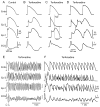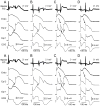Brugada Syndrome: Clinical, Genetic, Molecular, Cellular, and Ionic Aspects
- PMID: 26671757
- PMCID: PMC4737702
- DOI: 10.1016/j.cpcardiol.2015.06.002
Brugada Syndrome: Clinical, Genetic, Molecular, Cellular, and Ionic Aspects
Abstract
Brugada syndrome (BrS) is an inherited cardiac arrhythmia syndrome first described as a new clinical entity in 1992. Electrocardiographically characterized by distinct coved type ST segment elevation in the right-precordial leads, the syndrome is associated with a high risk for sudden cardiac death in young adults, and less frequently in infants and children. The electrocardiographic manifestations of BrS are often concealed and may be unmasked or aggravated by sodium channel blockers, a febrile state, vagotonic agents, as well as by tricyclic and tetracyclic antidepressants. An implantable cardioverter defibrillator is the most widely accepted approach to therapy. Pharmacologic therapy is designed to produce an inward shift in the balance of currents active during the early phases of the right ventricular action potential (AP) and can be used to abort electrical storms or as an adjunct or alternative to device therapy when use of an implantable cardioverter defibrillator is not possible. Isoproterenol, cilostazol, and milrinone boost calcium channel current and drugs like quinidine, bepridil, and the Chinese herb extract Wenxin Keli inhibit the transient outward current, acting to diminish the AP notch and thus to suppress the substrate and trigger for ventricular tachycardia or fibrillation. Radiofrequency ablation of the right ventricular outflow tract epicardium of patients with BrS has recently been shown to reduce arrhythmia vulnerability and the electrocardiographic manifestation of the disease, presumably by destroying the cells with more prominent AP notch. This review provides an overview of the clinical, genetic, molecular, and cellular aspects of BrS as well as the approach to therapy.
Copyright © 2016 Elsevier B.V. All rights reserved.
Conflict of interest statement
Figures






References
-
- Hermida JS, Lemoine JL, Aoun FB, Jarry G, Rey JL, Quiret JC. Prevalence of the brugada syndrome in an apparently healthy population. Am J Cardiol. 2000;86:91–94. - PubMed
-
- Postema PG. About Brugada syndrome and its prevalence. Europace. 2012;14:925–928. - PubMed
-
- Patel SS, Anees SS, Ferrick KJ. Prevalence of a Brugada pattern electrocardiogram in an urban population in the United States. Pacing Clin Electrophysiol. 2009;32:704–708. - PubMed
-
- Pecini R, Cedergreen P, Theilade S, Haunso S, Theilade J, Jensen GB. The prevalence and relevance of the Brugada-type electrocardiogram in the Danish general population: data from the Copenhagen City Heart Study. Europace. 1907;12:982–986. - PubMed
-
- Sinner MF, Pfeufer A, Perz S, Schulze-Bahr E, Monnig G, Eckardt L, Beckmann BM, Wichmann HE, Breithardt G, Steinbeck G, Fabritz L, Kaab S, Kirchhof P. Spontaneous Brugada electrocardiogram patterns are rare in the German general population: results from the KORA study. Europace. 2009;11:1338–1344. - PubMed
Publication types
MeSH terms
Substances
Grants and funding
LinkOut - more resources
Full Text Sources
Other Literature Sources

